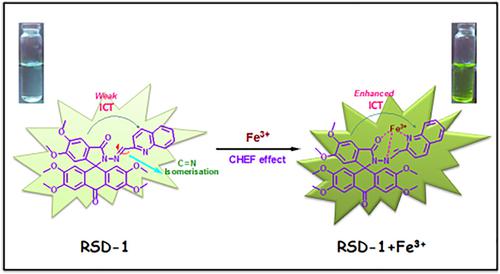当前位置:
X-MOL 学术
›
Appl. Organomet. Chem.
›
论文详情
Our official English website, www.x-mol.net, welcomes your
feedback! (Note: you will need to create a separate account there.)
Anthrone‐spirolactam and quinoline hybrid based sensor for selective fluorescent detection of Fe3+ ions
Applied Organometallic Chemistry ( IF 3.7 ) Pub Date : 2020-07-06 , DOI: 10.1002/aoc.5867 Ratanamala S. Darole 1, 2 , Denzil Britto Christopher Leslee 3 , Anagh Mukherjee 2, 4 , Rajesh G. Gonnade 2, 5 , Sekar Karuppannan 3 , Beeran Senthilkumar 1, 2
Applied Organometallic Chemistry ( IF 3.7 ) Pub Date : 2020-07-06 , DOI: 10.1002/aoc.5867 Ratanamala S. Darole 1, 2 , Denzil Britto Christopher Leslee 3 , Anagh Mukherjee 2, 4 , Rajesh G. Gonnade 2, 5 , Sekar Karuppannan 3 , Beeran Senthilkumar 1, 2
Affiliation

|
The synthesis of a novel, and highly selective Fe3+ ion sensor based on anthrone‐spirolactam and its quinoline hybrid ligand is reported. The designed ligand displayed selective detection of Fe3+ ions with enhanced fluorescence emission. The complexation of Fe3+ ion led to a red shift of 32 nm from 420 nm to 452 nm, and a several fold increase in intensity with fluorescent green emission. The complexation (detection) of Fe3+ ions with ligand resulted in chelation enhanced fluorescence and intramolecular charge transfer through the inhibition of C=N isomerization. This hybrid sensor shows high sensitivity and selectivity, spontaneous response, and works on a wide pH range a minimum detection limit of 6.83 × 10−8 M. Importantly, the sensor works through the fluorescence turn‐on mechanism that overcomes the paramagnetic effect of Fe3+ ions. The binding mechanism between the ligand and the Fe3+ ions was established from the Job's plot method, optical studies, Fourier transfor infrared spectroscopy, NMR titration, fluorescence life‐time studies, and density functional theory optimization. The sensor displayed excellent results in the quantification of Fe3+ ions from real water samples. Furthermore, due to its biocompatibility nature, fluorescent spotting of Fe3+ ions in live cells revealed its bioimaging applications.
中文翻译:

基于蒽醌-螺内酰胺和喹啉杂化的传感器,用于选择性荧光检测Fe3 +离子
报道了基于蒽酮-螺内酰胺及其喹啉杂化配体的新型,高选择性Fe 3+离子传感器的合成。设计的配体显示出具有增强的荧光发射的Fe 3+离子的选择性检测。Fe 3+离子的络合导致从420 nm到452 nm发生32 nm的红移,并且强度随着荧光绿色发射而增加了几倍。Fe 3+离子与配体的络合(检测)导致螯合增强的荧光和分子内电荷转移(通过抑制C = N异构化)。这种混合传感器显示出高灵敏度和选择性,自发响应,并在宽pH范围内工作,最低检测限为6.83×10 -8M.重要的是,传感器通过克服了Fe 3+离子的顺磁效应的荧光开启机制起作用。配位体与Fe 3+离子之间的结合机理是通过Job's绘图法,光学研究,傅立叶变换红外光谱,NMR滴定,荧光寿命研究和密度泛函理论优化建立的。该传感器在定量分析真实水样中的Fe 3+离子方面显示出优异的结果。此外,由于其生物相容性,活细胞中Fe 3+离子的荧光斑点揭示了其生物成像应用。
更新日期:2020-09-14
中文翻译:

基于蒽醌-螺内酰胺和喹啉杂化的传感器,用于选择性荧光检测Fe3 +离子
报道了基于蒽酮-螺内酰胺及其喹啉杂化配体的新型,高选择性Fe 3+离子传感器的合成。设计的配体显示出具有增强的荧光发射的Fe 3+离子的选择性检测。Fe 3+离子的络合导致从420 nm到452 nm发生32 nm的红移,并且强度随着荧光绿色发射而增加了几倍。Fe 3+离子与配体的络合(检测)导致螯合增强的荧光和分子内电荷转移(通过抑制C = N异构化)。这种混合传感器显示出高灵敏度和选择性,自发响应,并在宽pH范围内工作,最低检测限为6.83×10 -8M.重要的是,传感器通过克服了Fe 3+离子的顺磁效应的荧光开启机制起作用。配位体与Fe 3+离子之间的结合机理是通过Job's绘图法,光学研究,傅立叶变换红外光谱,NMR滴定,荧光寿命研究和密度泛函理论优化建立的。该传感器在定量分析真实水样中的Fe 3+离子方面显示出优异的结果。此外,由于其生物相容性,活细胞中Fe 3+离子的荧光斑点揭示了其生物成像应用。











































 京公网安备 11010802027423号
京公网安备 11010802027423号